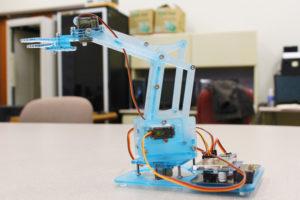 When Penn State University industrial engineering doctoral student Rakshith Badarinath was just a child, he already knew that his future would involve a career in manufacturing. With his eyes glued to Discovery Channel shows about car factories and the like, he eventually decided to pursue a bachelor’s degree in electrical engineering from the Siddagana Institute of Technology in India. Following that, Badarinath ended up attending Penn State for his graduate studies, which is where he was introduced to 3D printing technology for the first time in his life.
When Penn State University industrial engineering doctoral student Rakshith Badarinath was just a child, he already knew that his future would involve a career in manufacturing. With his eyes glued to Discovery Channel shows about car factories and the like, he eventually decided to pursue a bachelor’s degree in electrical engineering from the Siddagana Institute of Technology in India. Following that, Badarinath ended up attending Penn State for his graduate studies, which is where he was introduced to 3D printing technology for the first time in his life.
Ever since that fateful day, Badarinath has been working with faculty members from the Harold and Inge Marcus Department of Industrial and Manufacturing Engineering to convert old machines into 3D printers for the department’s Factory for Advanced Manufacturing Education (FAME) lab. Now, Badarinath has collaborated with Shu Shu Wang, who at the start of the project was working toward her master’s degree in industrial engineering, to build a robotic arm with the help of multiple 3D printing processes. The two innovators were connected by their advisor, Vittal Prabhu, and together, they worked to develop a robotic arm that would help improve manufacturing operations.

Penn State industrial engineering doctoral student Rakshith Badarinath and the 3D printed robotic arm. [Photo: Emily Chambers / Penn State News]
“We were focused on seeing if 3D printing would change the functionality of the arm,” Badarinath said. “Different processes can render different results. We wanted to know which was the most accurate and if inaccuracies would alter the end effect for the arm, which is extending and then gripping something.”
 Since the completion of their project, Wang has graduated with her master’s degree, while Badarinath still has three years left in his program, and is already off to another project. 3D printing technology has become a valuable asset for the production of robotic arms, whether they’re used for educational or assistive purposes. In the case of the two Penn State students, their 3D printed robotic arm project was just an enjoyable side project. Currently, Badarinath is working on a major personal project, which involves using industrial robotics for 3D printing technology. Discuss further in the 3D Printed Robotic Arm forum over at 3DPB.com.
Since the completion of their project, Wang has graduated with her master’s degree, while Badarinath still has three years left in his program, and is already off to another project. 3D printing technology has become a valuable asset for the production of robotic arms, whether they’re used for educational or assistive purposes. In the case of the two Penn State students, their 3D printed robotic arm project was just an enjoyable side project. Currently, Badarinath is working on a major personal project, which involves using industrial robotics for 3D printing technology. Discuss further in the 3D Printed Robotic Arm forum over at 3DPB.com.
Subscribe to Our Email Newsletter
Stay up-to-date on all the latest news from the 3D printing industry and receive information and offers from third party vendors.
You May Also Like
3D Printing Unpeeled: Biofuel Waste to Filament & Sustainable Photopolymers
I can’t ever remember a day with so many potentially high impact news stories have come out. In one story, we all know that there are problems with the safety...
Finnair Hires AM Craft to 3D Print Plastic Parts for Aircraft Interiors
Riga-based AM Craft, a supplier specialized in 3D printing aviation components and certified under EASA Part 21G, announced a significant achievement today. The company will assist in upgrading Finnair’s A320...
3DPOD Episode 198: High Speed Sintering with Neil Hopkinson, VP of AM at Stratasys
Neil Hopkinson, a pioneering 3D printing researcher, played a pivotal role in developing a body of research that is widely utilized today. He also invented High Speed Sintering (HSS), also...
3D Printing Webinar and Event Roundup: May 12, 2024
Webinars and events are picking up in the AM industry this week! ASTM International continues its Professional Certificate Course and Stratasys continues its advanced in-person trainings, while 3D Systems is...
































